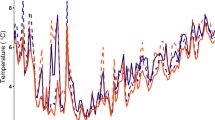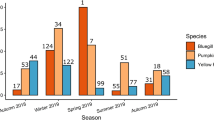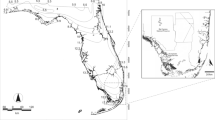Abstract
In this study, we demonstrate that non-native Pumpkinseed (Lepomis gibbosus) introduced into Spanish water-bodies almost 100 years ago have a reduced capacity to tolerate winter conditions typically experienced by northern native populations. Overwinter survival and changes in lean weight and lipid content of Pumpkinseed from artificial colonies established from two Canadian and two Iberian source populations were compared under winter conditions typically experienced in the northern native range. Adult survival in outdoor ponds was higher in Canadian populations (68 and 78 %) than Iberian populations (31 and 49 %). Under simulated winter conditions in the laboratory, juvenile Iberian Pumpkinseed experienced higher mortality earlier in the winter period than Canadian populations. Lipid content of Iberian juveniles decreased on average by 49 % during the first half of the winter, while that of Canadian populations decreased by only 12–20 %. These results indicate that Iberian Pumpkinseed have lower tolerance of winter conditions relative to native Canadian populations, and suggest that relatively short exposure to warm climates can result in adaptive change in the physiology and bioenergetics of wild fish populations.





Similar content being viewed by others
References
Angilletta MJ (2009) Thermal adaptations: a theoretical and empirical synthesis. Oxford University Press, Oxford, p 14
Arnold A (1990) Eingebürgerte fischarten: Die Neue Brehm-Bücherei Band 602. Westarp Wissenschaften, pp 34–60
Atkins KE, Travis JMJ (2010) Local adaptation and the evolution of species’ ranges under climate change. J Theor Biol 266:449–457
Barrett RDH, Paccard A, Healy TM, Bergek S, Schulte PM, Schluter D, Rogers SM (2011) Rapid evolution of cold tolerance in stickleback. Proc R Soc B 278:233–238
Berg OK, Finstad AG, Solem Ø, Ugedal O, Forseth T, Niemelä E, Arnekleiv J, Lohrmann A, Næsje TF (2009) Pre-winter lipid stores in young-of-year Atlantic salmon along a north-south gradient. J Fish Biol 74:1383–1393
Bernard G, Fox MG (1997) Effects of body size and population density on overwinter survival of age-0 pumpkinseeds. N Am J Fish Manage 17:581–590
Biro PA, Morton AE, Post JR, Parkinson EA (2004) Over-winter lipid depletion and mortality of age-0 rainbow trout (Oncorhynchus mykiss). Can J Fish Aquat Sci 61:1513–1519
Bodensteiner LR, Sheehan RJ, Wills PS, Brandenburg AM, Lewis WM (2000) Flowing water: an effective treatment for Ichthyophthiriasis. J Aquat Anim Health 12:209–219
Byström P, Andersson J, Kiessling A, Eriksson L-O (2006) Size and temperature dependent foraging capacities and metabolism: consequences for winter starvation mortality in fish. Oikos 115:43–52
Cargnelli LM, Gross MR (1996) The temporal dimension in fish recruitment: birth date, body size, and size-dependent survival in a sunfish (bluegill: Lepomis macrochirus). Can J Fish Aquat Sci 53:360–367
Chambers RC, Leggett WC (1989) Event analysis applied to timing in marine fish ontogeny. Can J Fish Aquat Sci 46:1633–1641
Clements DR, Ditommaso A (2011) Climate change and weed adaptation: can evolution of invasive plants lead to greater range expansion than forecasted? Weed Res 51:227–240
Copp GH, Fox MG (2007) Growth and life history traits of introduced pumpkinseed (Lepomis gibbosus) in Europe, and the relevance to its potential invasiveness. In: Gherardi F (ed) Biological invaders in inland waters: profiles, distribution, and threats. Springer, Dordrecht, p 289–306
de Groot S (1985) Introductions of non-indigenous fish species for release and culture in The Netherlands. Aquaculture 46:237–257
De Meester L, Van Doorslaer W, Geerts A, Orsini L, Stoks R (2011) Thermal genetic adaptation in the water flea Daphnia and its impact: an evolving metacommunity approach. Integr Comp Physiol 51:703–718
Detta AM (2011) The genetic origin and dispersal of introduced pumpkinseed (Lepomis gibbosus) in the Iberian Peninsula. Dissertation, Trent University
Elvira B, Almodóvar A (2001) Freshwater fish introductions in Spain: facts and figures at the beginning of the 21st century. J Fish Biol 59(Suppl A):323–331
Fetzer WW, Brooking TE, Jackson JR, Rudstam LG (2011) Overwinter mortality of gizzard shad: evaluation of starvation and cold temperature stress. Trans Am Fish Soc 140:1460–1471
Finstad AG, Berg OK, Forseth T, Ugedal O, Næsje TF (2010) Adaptive winter survival strategies: defended energy levels in juvenile Atlantic salmon along a latitudinal gradient. Proc R Soc B 277:1113–1120
Fox MG (1994) Growth, density, and interspecific influences on pumpkinseed sunfish life histories. Ecol 75:1157–1171
Fox MG, Vila-Gispert A, Copp GH (2007) Life-history traits of introduced Iberian pumpkinseed Lepomis gibbosus relative to native populations. Can differences explain colonization success? J Fish Biol 71(Suppl D):56–69
Fullerton AH, Garvey JE, Wright RA, Stein RA (2000) Overwinter growth and survival of largemouth bass: interactions among size, food, origin, and winter severity. Trans Am Fish Soc 129:1–12
Futuyma DJ, Bennett AF (2009) The importance of experimental studies in evolutionary biology. In: Garland T Jr, Rose RR (eds) Experimental evolution: concepts, methods, and applications of selection experiments. University of California Press, California
García-Berthou E, Moreno-Amich R (2000a) Introduction of exotic fish into a Mediterranean lake over a 90-year period. Arch Hydrobiol 149:271–284
García-Berthou E, Moreno-Amich R (2000b) Food of introduced pumpkinseed sunfish: ontogenetic diet shift and seasonal variation. J Fish Biol 57:29–40
García-Berthou E, Alcaraz C, Pou-Rovira Q, Zamora L, Feo C (2005) Introduction pathways and establishment rates of invasive aquatic species in Europe. Can J Fish Aquat Sci 62:453–463
Garvey JE, Wright RA, Stein RA (1998) Overwinter growth and survival of age-0 largemouth bass (Micropterus salmoides): revisiting the role of body size. Can J Fish Aquat Sci 55:2414–2424
Garvey JE, Herra TP, Leggett WC (2002) Protracted reproduction in sunfish: the temporal dimension in fish recruitment revisited. Ecol Appl 12:194–205
Godinho FN, Ferreira MT, Cortes RV (1997) Composition and spatial organization of fish assemblages in the lower Guadiana basin, southern Iberia. Ecol Freshw Fish 6:134–143
Gutowsky LFG, Fox MG (2011) Occupation, body size and sex ratio of round goby (Neogobius melanostomus) in established and newly invaded areas of an Ontario river. Hydrobiologia 671:27–37
Heermann L, Eriksson L-O, Magnhagen C, Borcherding J (2009) Size-dependent energy storage and winter mortality of perch. Ecol Freshw Fish 18:560–571
Hendry AP, Hensleigh JE, Reisenbichler RR (1998) Incubation temperature, developmental biology, and the divergence of sockeye salmon (Oncorhynchus nerka) within Lake Washington. Can J Fish Aquat Sci 55:1387–1394
Hoffmann AA, Sørensen JG, Loeschcke V (2003) Adaptation of Drosophila to temperature extremes: bringing together quantitative and molecular approaches. J Therm Biol 28:175–216
Hurst TP (2007) Causes and consequences of winter mortality in fishes. J Fish Biol 71:315–345
Hurst TP, Conover DO (2003) Seasonal and interannual variation in the allometry of energy allocation in juvenile striped bass. Ecology 84:3360–3369
Hurst TP, Schultz ET, Conover DO (2000) Seasonal energy dynamics of young-of-the-year Hudson River striped bass. Trans Am Fish Soc 129:145–157
Hutchings JA (1994) Age- and size-specific costs of reproduction within populations of brook trout, Salvelinus fontinalis. Oikos 70:12–20
Ineno T, Tsuchida S, Kanda M, Watabe S (2005) Thermal tolerance of a rainbow trout Oncorhynchus mykiss strain selected by high-temperature breeding. Fish Sci 71:767–775
Johnson TB, Evans DO (1991) Behaviour, energetics and associated mortality of young-of-the-year white perch (Morone americana) and yellow perch (Perca flavescens) under simulated winter conditions. Can J Fish Aquat Sci 48:672–680
Johnson TB, Evans DO (1996) Temperature constraints on overwinter survival of age-0 white perch. Trans Am Fish Soc 125:446–471
Kavanagh KD, Haugen TO, Gregersen F, Jernvall J, Vøllestad LA (2010) Contemporary temperature-driven divergence in a Nordic freshwater fish under conditions commonly thought to hinder adaptation. BMC Evol Biol 10:350–362
Keast A (1968) Feeding of some Great Lakes fishes at low temperatures. J Fish Res Board Can 25:1199–1218
Kooka K, Yamamura O, Andoh T (2007) Rate of energy depletion and overwinter mortality of juvenile walleye pollock in cold water. J Fish Biol 71:1714–1734
Künstler J (1908) Amiurus nebulosus et Eupomotis gibbosus. Bull Soc Nat d’Acclim 238–244
Le Morvan C, Troutaud D, Deschaux P (1998) Differential effects of temperature on specific and nonspecific immune defences in fish. J Exp Biol 201:165–168
Lepak JM, Kraft CE (2008) Alewife mortality, condition, and immune response to prolonged cold temperatures. J Great Lakes Res 34:134–142
Lever C (1977) The naturalized animals of the British Isles. In: 1st edn. Hutchinson & Co. Ltd, Great Britain, p 484
Maazouzi C, Médoc V, Pihan J-C, Masson G (2011) Size-related dietary changes observed in young-of-the-year pumpkinseed (Lepomis gibbosus): stomach contents and fatty acid analyses. Aquat Ecol 45:22–33
Mather F (1889) Report of eggs shipped to and received from foreign countries at the Cold Spring Harbor, New York, Station during the season of 1886–1887. In: Rep Commissioner U.S. Comm Fish Fisheries for 1886, Part XXVI, Government Print Office, Washington, p 829
McCollum AB, Bunnell DB, Stein RA (2003) Cold, northern winters: the importance of temperature to overwinter mortality of age-0 white crappies. Trans Am Fish Soc 132:977–987
Micucci SM, Garvey JE, Wright RA, Stein RA (2003) Individual growth and foraging responses of age-0 largemouth bass to mixed prey assemblages during winter. Environ Biol Fish 67:157–168
Miranda L, Hubbard W (1994) Length-dependent winter survival and lipid composition of age-0 largemouth bass in Bay Springs Reservoir, Mississippi. Trans Am Fish Soc 123:80–87
National Climatic Data Centre (2012) World’s largest archive of climatic data. http://www.ncdc.noaa.gov/cdo-web/. Accessed 02 Sept 2013
Nelson W (1982) Applied life data analysis. Wiley, New York, p 538
Ohlberger J, Mehner T, Staaks G, Hölker F (2008) Temperature-related physiological adaptations promote ecological divergence in a sympatric species pair of temperate freshwater fish, Coregonus spp. Funct Ecol 22:501–508
Peck LS, Clark MS, Morley SA, Massey A, Rossetti H (2009) Animal temperature limits and ecological relevance: effects of size, activity and rates of change. Funct Ecol 23:248–256
Pinheiro J, Bates D, DebRoy S, Sarkar D, and the R Development Core Team (2011) nlme: linear and non-linear mixed effect models. R package version 3.1-101. http://CRAN.R-project.org/package=nlme
Pratt TA, Fox MG (2002) Influence of predation risk on the overwinter mortality and energetic relationship of young-of-year Walleyes. Trans Am Fish Soc 131:885–898
R Development Core Team (2011) R: a language and environment for statistical computing. R Foundation for Statistical Computing, Vienna, Austria. http://www.R-project.org/
Rach JJ, Marks JA, Dawson VK (1995) Effect of water flow rates in hatching jars to control fungal infections of rainbow trout eggs. Prog Fish-Cult 57:226–230
Schaefer J, Walters A (2010) Metabolic cold adaptation and developmental plasticity in metabolic rates among species in the Fundulus notatus species complex. Funct Ecol 24:1087–1094
Scheipl F, Grevan S, Kuechenhoff H (2008). Size and power of tests for a zero random effect variance or polynomial regression in additive and linear mixed models. Comput Stat Data An 52:3283–3299. http://CRAN.R-project.org/package=RLRsim
Schultz ET, Conover DO (1997) Latitudinal differences in somatic energy storage: adaptive responses to seasonality in an estuarine fish (Atherinidae: Menidia menidia). Oecologia 109:516–529
Schultz ET, Conover DO (1999) The allometry of energy reserve depletion: test of a mechanism for size-dependent winter mortality. Oecologia 119:474–483
Schultz ET, Conover DO, Ehtisham A (1998) The dead of winter: size-dependent variation and genetic differences in seasonal mortality among Atlantic silverside (Atherinidae: Menidia menidia) from different latitudes. Can J Fish Aquat Sci 55:1149–1157
Schumacher FX, Eschmeyer RW (1943) The estimate of fish population in lakes or ponds. J Tenn Acad Sci 18:228–249
Scott WB, Crossman EJ (1973) Freshwater fishes of Canada. In: Fisheries Research Board of Canada, Ottawa, p 715
Shoup DE, Wahl DH (2008) The effect of largemouth bass predation on overwinter survival of two size-classes of age-0 bluegills. Trans Am Fish Soc 137:1063–1071
Shoup DE, Wahl DH (2011) Body size, food, and temperature affect overwinter survival of age-0 bluegills. Trans Am Fish Soc 140:1298–1304
Shuter BJ, Post JR (1990) Climate, population viability, and the zoogeography of temperate fishes. Trans Am Fish Soc 119:314–336
Shuter BJ, Finstad AG, Helland IP, Zweimüller I, Hölker F (2012) The role of winter phenology in shaping the ecology of freshwater fish and their sensitivities to climate change. Aquat Sci 74:637–657
Somero GN (2011) Comparative physiology: a “crystal ball” for predicting consequences of global change. Am J Physiol Regul Integr Comp Physiol 301:R1–R14
Therneau T, Lumley T (2011) Survival: survival analysis, including penalised likelihood. R package version 2.36-9. http://CRAN.R-project.org/package=survival
Vila-Gispert A, Alcaraz C, García-Berthou E (2005) Life-history traits of invasive fish in small Mediterranean streams. Biol Invasions 7:107–116
Vila-Gispert A, Fox MG, Zamora L, Moreno-Amich R (2007) Morphological variation in pumpkinseed Lepomis gibbosus introduced into Iberian lakes and reservoirs; adaptations to habitat type and diet? J Fish Biol 71:163–181
Visser ME (2008) Keeping up with a warming world; assessing the rate of adaptation to climate change. Proc R Soc B 275:649–659
Zar JH (2010) Biostatistical analysis, 5th edn. Prentice-Hall Inc, Upper Saddle River
Acknowledgments
The authors wish to thank A. Vila-Gispert, L. Zamora and R. Moreno-Amich for providing the original Spanish Pumpkinseed used to establish the pond collections, D. Algera, J. Brownscombe, J. Gobin, B. Houston, M. Lloyst, J. Stacey and S. Yavno for their assistance in the field, and E. Chin, G. Burness, T. Metcalfe and B. McIlwain for their assistance with lipid analysis. Funding was provided by the Natural Sciences and Engineering Research Council of Canada to MGF and AR, and by the Ontario Ministry of Training, Colleges and Universities in the form of an Ontario Graduate Scholarship to AR.
Author information
Authors and Affiliations
Corresponding author
Rights and permissions
About this article
Cite this article
Rooke, A.C., Fox, M.G. Living a century in warm thermal conditions: introduced populations of Pumpkinseed (Lepomis gibbosus) inhabiting the Iberian Peninsula (Spain) show reduced adaptation to North American winter conditions. Aquat Sci 76, 497–509 (2014). https://doi.org/10.1007/s00027-014-0349-4
Received:
Accepted:
Published:
Issue Date:
DOI: https://doi.org/10.1007/s00027-014-0349-4




